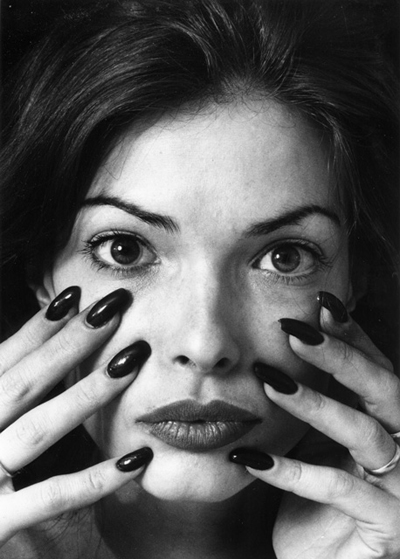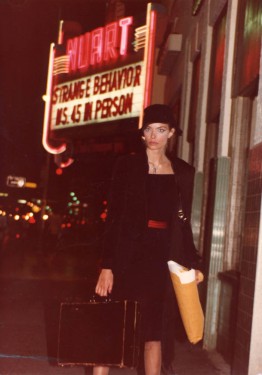 Back to selection
Back to selection
FILMMAKER PAUL RACHMAN REMEMBERS ZOE LUND

 I interviewed Zoe Lund for the second issue of Filmmaker, back when we put Abel Ferrara’s Bad Lieutenant on the cover.She was the screenwriter, and she also appeared in one of the film’s most memorable scenes. Previously, Lund starred in a number of films, including Ferrara’s breakthrough, Ms. 45. Lund was fascinating, beautiful, talented, and she had a unique and powerful charisma.She died in Paris in 1999.
I interviewed Zoe Lund for the second issue of Filmmaker, back when we put Abel Ferrara’s Bad Lieutenant on the cover.She was the screenwriter, and she also appeared in one of the film’s most memorable scenes. Previously, Lund starred in a number of films, including Ferrara’s breakthrough, Ms. 45. Lund was fascinating, beautiful, talented, and she had a unique and powerful charisma.She died in Paris in 1999.
Recently I ran into filmmaker and Slamdance co-founder Paul Rachman, and he told me about the series of short documentary films he’s making about Lund. He agreed to answer a few questions about Lund, the project and himself for Filmmaker and to give our readers a sneak peek at the latest in the series.
Filmmaker: When did you first meet Zoe, and when did you first decide to make this series of films?
Paul Rachman: I first met Zoe Tamerlis Lund in New York City in 1986 when she started dating Robert Lund. Robert worked as an engineer/designer at the big TV/video facilities of a past era, such as VCA Teletronics, Unitel and Post Perfect — places with one-inch tape machines, switchers, Ampex ADO’s and Quantel Paintboxes! Soon after college I worked as a freelance editor at most of the same facilities Robert worked at. At night very late I would work on my own stuff like the music videos for Bad Brains, Gang Green, Mission of Burma which I had shot a few years earlier and finally had access to equipment to make something of them. Zoe would come by late as well, hang around a little and then as a group we would all go out and hit the clubs like the fading Danceteria, The World, Limelight, Tunnel and after hours at Save the Robots or Continental (not the current bar) and then end up at Zoe and Robert’s 10th street apartment with their dozens of roaming pet rats which are featured in Zoe XO the first short film I made about Zoe. Robert and Zoe were married later that same year. This friendship and camaraderie continued through 1989 at which point I moved to Los Angeles to direct music videos. I never saw her again after that but I kept aware of her career and kept in touch with Robert and others from the group of friends. When I moved back to New York in 1999 I ran into Robert and I learned that he and Zoe had split up in 1997, that she had moved to Paris and had recently passed away there. I was shocked but not surprised. Robert still held a lot of passion for her; they had never divorced so he was legally her her widow. He started talking to me about her every time I saw him and inviting me over to look at all her stuff that had been left behind — clothes, photos, writings, etc… Zoe was a Bukowskiesque artist, heroin was her fuel, she and Robert lived it for real but with that lifestyle there inevitably was also a darker, manipulative side to things: the repetitive slide downward that comes with drug addiction. Robert would reminisce about her, both the good and the bad. It was all very poignant so I decided to make a short Zoe XO, a love poem of sorts from Robert about Zoe and their short life together. The latest short, which I completed this past September, Zoe Rising is about her childhood through the fading memories of her aging mother, sculptor Babrabra Lekberg. Until this film Barbara had never really openly talked about Zoe’s death nor had she actually come to terms with it, really. The idea of a continuing a series of shorts about Zoe came to me in between these two films.
 Filmmaker: What was special about Zoe as an artist, and what do you hope to convey with these shorts?
Filmmaker: What was special about Zoe as an artist, and what do you hope to convey with these shorts?
Rachman: Zoe was the prototypical downtown New York artist, diva, mover and glamorous junkie. She was what hip people today want to be, albeit without the heroin, but that was a big part of it. She was a chameleon, enigmatic, always finding ways to fit into the moment, constantly finding ways to be creative, pushing her ideas on everyone she met who was also an artistic enabler of any kind. She was always expressing herself whether it was a modeling job, an acting job, or her newest script or novel idea. She would be up close in your face telling you every detail. In retrospect I think I was always around Zoe and Robert at the peaks of her heroin highs or in “good” moments. I would eventually also hear from Robert and from Barbara about some of the darker stories related to the lifestyle of addiction; the lying, stealing and manipulating mostly with the goal of getting the next fix. It was this complex mix in her life and personality and the fact that so many people had such different experiences with her that fascinated me and drew me into this side project. The fragmented short film approach was similar to the way I was finding more out about her, an aggregation of moments that would add up to a finished puzzle, with probably a few pieces missing.
Filmmaker: Tell me about your process of making these short films in stages. Is this a function of budget, your time, or are you discovering things about Zoe by virtue of spacing these projects out? And which parts are upcoming?
Rachman: I initially set out just to make one short, Zoe XO, but as I was finishing it I thought it would be great to know more about Zoe from different people and experiences. At that time in 2003/04 I was buried in mid production on my last feature doc American Hardcore so another doc feature was not something I was thinking of embarking on. I also liked the simplicity and freedom that the first film Zoe XO presented and thought that a more non linear/experimental approach would be more suitable to Zoe’s personality and life experiences. As a very independent filmmaker I was excited about the freedom to make a new short every year, a continuing story about an intriguing subject, a character that no one person knows the whole story about. I also owned all the tools so it was very inexpensive and doable. What’s so nice about a multiple short film approach is that it allows for a simpler, self-contained creative process that repeats itself, a moment-by-moment approach, the aggregation of which will amount to a longer film which can be reedited a bit to connect Zoe’s moments over her entire life. Zoe XO was about her husband and marriage, Zoe Rising is about her mother and childhood. Next are several people she worked with, then people she was friends with and involved with while living in France at the end of her life.
Filmmaker: How do you intend to finally release these shorts, and why are you keeping them relatively private so far?
Rachman: Eventually I would like to aggregate them into a feature-length set of stories about Zoe. The dark portrait of an intense artist from a time when being that intense was an accepted way of life in downtown New York. As for the exposure of the short films themselves I’m not trying to actively keep them private but rather I am trying to play them each the first time in a significant way, like at a few film festivals, and then show them in limited ways over the web to get the community that knows her aware of the project, which in turn can maybe attract more people who have more stories about her. The whole thing is a bit experimental, and I like that about it. In a funny way I sometimes feel that the project is being forced into this weird experimental state as if Zoe was manipulating it from wherever she is, there is a particular energy about these shorts that’s hard to explain. As a filmmaker who has worked in many different forms over the years it’s kind of nice to have a project like this happening on the side while I am neck deep in other more traditional types of productions like Lost Rockers, my current feature doc in post.
Filmmaker: Zoe was a real character in a downtown New York that doesn’t exist so much any more. Or, at least, that’s my take. Do you think these pieces are time capsules of another time, or simply a personal portrait?
Rachman: Zoe definitely was part of a bygone New York downtown gritty era and scene. These films will evoke that as well as the personal aspects of her life and work while inevitably crossing over into that ’80s time and place. Who, what, where, when, and how are all part of the equation when traveling backwards into someone’s life. With this project I am letting each short film lead me to another step, story, or person. Each person inspires a different approach to shooting them, I like the subjects to be “doing” something while they talk about her, Robert was driving, Barbara was sculpting so we also learn something about them through observation. There is no real outline, synopsis or plan — it is basically choosing who I can talk to next, choosing how to shoot them, then shooting and cutting it, which is always the best part of the process. Hopefully the films will find their place for all the right reasons.
Photo credit: top, taken at the Rotterdam Film Festival in 1993 by Caspari De Geus.
ZOE XO from paul rachman on Vimeo.
ZOR RISING (2011) Excerpt from paul rachman on Vimeo.
